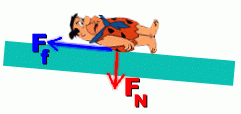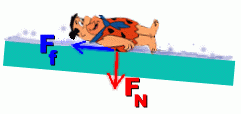|
You probably know that if the water is turned off, you won't be able to slide at all. Plastic isn't very slippery. The concept involved here is friction; dry plastic has a high coefficient of friction. The 'coefficient of friction' is a number that represents how much friction there is between two surfaces (in this case, between your rear end and the slide). The symbol for the coefficient looks like this: It's a Greek letter (like pi) that resembles a u with a tail on the front. The smaller this number, the less friction there is. The larger the number, the more friction. You can actually work out how much friction force there is between two surfaces, using the surfaces' coefficient of friction and the following equation: The quantity FN represents the normal force, which is the force pulling your body onto the slide. This is a component of the force of gravity. The steeper the slide, the smaller FN is, ... so the smaller the force of friction Ff will be. For a vertical drop, FN is zero, and so is the frictional force between you and the slide.  Here's the slide with no water. The surfaces in contact are your body and dry plastic. The coefficient of friction will be a large number.
Here's the slide with no water. The surfaces in contact are your body and dry plastic. The coefficient of friction will be a large number.Multiplying it by FN will yield a large frictional force Ff. (Notice, by the way, that the direction of the frictional force is opposite to the direction of motion. This is always the case ... friction acts to slow you down.)  Here's the slide with water. The surfaces in contact are your body and wet plastic. The coefficient of friction for these surfaces is a very small number. Here's the slide with water. The surfaces in contact are your body and wet plastic. The coefficient of friction for these surfaces is a very small number.(The angle of the slide hasn't changed, so the normal force remains the same). Multiplying the small coefficient by FN will yield a small frictional force Ff. Because the coefficient of friction between you and the wet slide is smaller, the frictional force is smaller. Since friction acts to slow you down by reducing the component of gravity's force that's causing you to accelerate, you can now accelerate faster down the slide. Large water slides will have a powerful flow of water. This force will also help to propel you down the slide. |